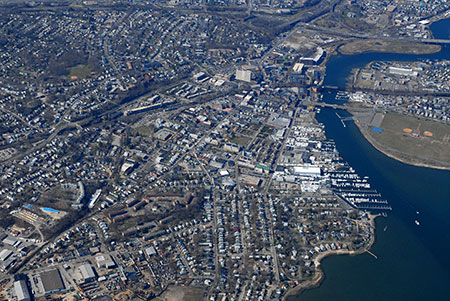February 22, 2019
 In the past year, Norwalk has been undergoing its 10-year citywide planning process, as well as developing plans for other economic development projects, including for the Wall Street/WestAvenue district, among others. As Norwalk seeks to include best practices and innovations in city planning, we thought we’d take a look at recent trends in urban planning.
In the past year, Norwalk has been undergoing its 10-year citywide planning process, as well as developing plans for other economic development projects, including for the Wall Street/WestAvenue district, among others. As Norwalk seeks to include best practices and innovations in city planning, we thought we’d take a look at recent trends in urban planning.
Sustainability
With the environment and climate change ever more on the minds of those in the U.S., expect urban planning to include sustainability and the minimization of environmental impacts earlier on and as an ever more important component of the planning process. These include such things as bold new ways to curb urban growth boundaries, design for carbon reduction using more sustainable materials, HVAC systems, water conservation, environmentally friendly landscaping, and construction methods. The idea of building with climate resilience in mind will also become more important. This is urban planning for the capacity to adapt to environmental change or spring back from a disaster.
This trend in energy conservation and sustainability is synching with technology as we see an increased emphasis on intelligent buildings to monitor resource consumption, boost efficiency and reduce energy costs. You will notice that both the POCD and the Wall-West Plan have a multitude of sustainability components to guide Norwalk in growing sustainably.
Smart Cities
Speaking of intelligent buildings, that brings us to the second trend – investing in “smart city” technology. Technology is taking a larger role as planners think of how a city should work. Not only can technology bring efficiencies that lead to lower carbon footprint, lower costs and resilient infrastructure, but also automation is a growing trend that brings benefits. In addition to monitoring energy, other beneficial uses of automation include providing better security, assisting first responders to a crime or disaster, and better coordinating public transportation.
Multi-Modal Transportation
Urban planning with public transportation in mind is not new, but developing land uses around diverse transportation options is a growing trend. We see more planning for land use that affects accessibility to walking and cycling routes, along with public transportation as options for residents and commuters. This goes hand-in-hand with the increase in planning for transit-oriented development – creating compact, walkable, pedestrian-oriented, mixed-use communities centered around high quality public transportation. Mixed-use communities are where homes are within walking distance of stores, public spaces, and employment, basically “neighborhoods” within a city. Transit-oriented development makes it possible to live in an urban location without relying on a car. You will see TOD development in both South Norwalk and East Norwalk Train Station neighborhoods.
Public Open Spaces
Urban planning now includes a greater focus on the value of public and open spaces not only as a design/aesthetic element, but also from a dollar value. Proximity to parks and open spaces with walking, biking and jogging paths has proven to increase rents and property values. In addition, public open spaces boost overall quality of life and wellness of residents, by encouraging walking, cycling and relaxing.
Common areas built around housing allow people places where they can safely relax and people watch. These public spaces can also include sitting areas with internet connectivity where people can work or relax. In addition these spaces include plants, water features, public art, exercise equipment, playgrounds, and pet parks.
If you would like to read about how these trends fit into the Citywide Plan or the plan for the West Avenue/Wall Street area, click on the links below.




